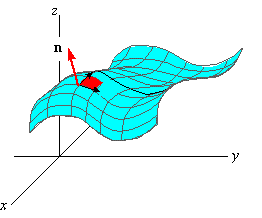The Surface Normal
One of the most important concepts in studying surfaces is the
concept of the unit normal to the surface. In particular, it
will become prominent in chapter 5 as we generalize the fundamental theorem
of calculus to more than one variable.
Suppose that r( u,v) is a regular parametrization of
a surface. Since the crossproduct ru×rv is
orthogonal to both ru and rv, the vector ru×rv is normal to the surface at r( u,v) . It follows that the unit vector
is also normal to the surface. The vector n is thus called the
unit normal to the surface.
It is important to note that n = n( u,v) is a function
of u and v.
EXAMPLE 1 Find the unit normal to the cylinder
|
r( u,v) =
á cos( u) ,sin(u) ,v
ñ |
|
Solution: Since ru =
á -sin( u),cos( u) ,0
ñ = -sin( u) i+cos( u) j and since rv =
á0,0,1
ñ = k, their cross product is
|
ru×rv |
= |
( -sin( u) i+cos( u) j) ×k |
|
= |
-sin( u) i×k+cos( u) j×k |
|
= |
sin( u) j+cos( u) i |
|
That is, ru×rv =
á cos(u), sin( u), 0
ñ . Moreover, | | ru×rv| | 2 = cos2(u)
+ sin2( u) = 1, so that
|
n = |
ru×rv
|| ru×rv
||
|
=
á cos(u) ,sin( u) ,0
ñ |
|
as is shown in the image below:
Thus, at the point rotated u radians from the x-axis and v units
vertically from the xy-plane, the normal to the
cylinder is n =
á cos(u), sin( u), 0
ñ.
If the surface is given in spherical or cylindrical coordinates,
then we first use the relationships for x, y, and z, respectively, to
obtain a parameterization of the surface. We will consider only cylindrical
coordinates here. Spherical coordinates are included in the worksheet.
EXAMPLE 2 Find the surface normal for the surface in
cylindrical coordinates given by z = r+1.
Solution: The function z = r+1 combined with x = rcos( q) and y = rsin( q) leads to the parameterization
|
r( r,q) =
á rcos( q),rsin( q) ,r+1
ñ |
|
Since rr =
á cos( q) ,sin(q) ,1
ñ and rq =
á-rsin( q) ,rcos( q) ,0
ñ ,
the cross product is
|
rr × rq =
á -rcosq, -rsinq, r
ñ |
|
Moreover, || rr×rq|| = rÖ2, so that the surface normal is
|
n = |
rr×rq
|| rr×rq||
|
= |
|

|
-cosq
Ö2
|
, |
-sinq
Ö2
|
, |
1
Ö2
|  |
|
|
A surface S is said to be oriented if the surface
normals at each point on the surface all point toward one side of the
surface.
Equivalently, a surface is oriented if n is uniquely defined at
each point and varies continuously on the surface. (Not all surfaces can be
oriented. For example, a Moebius strip, which can be formed by twisting a
strip of paper one half turn and pasting the two ends together, cannot be
oriented).
If a surface is closed, then we assume its orientation to be with all normal
vectors pointing toward the outside of the surface.
Check Your Reading: Is a sphere an oriented surface?

